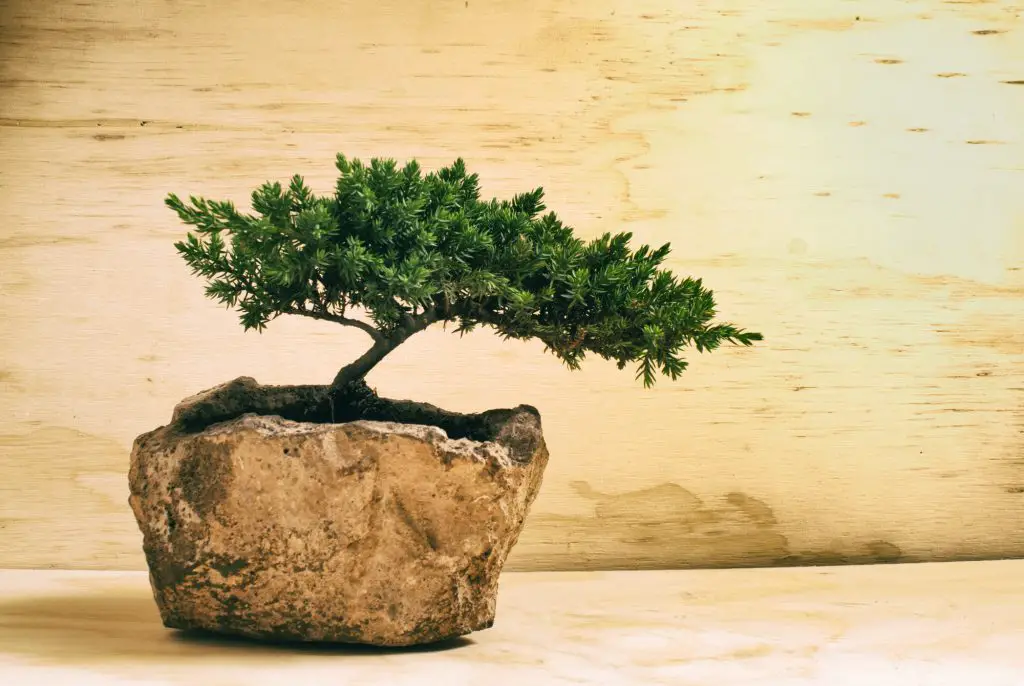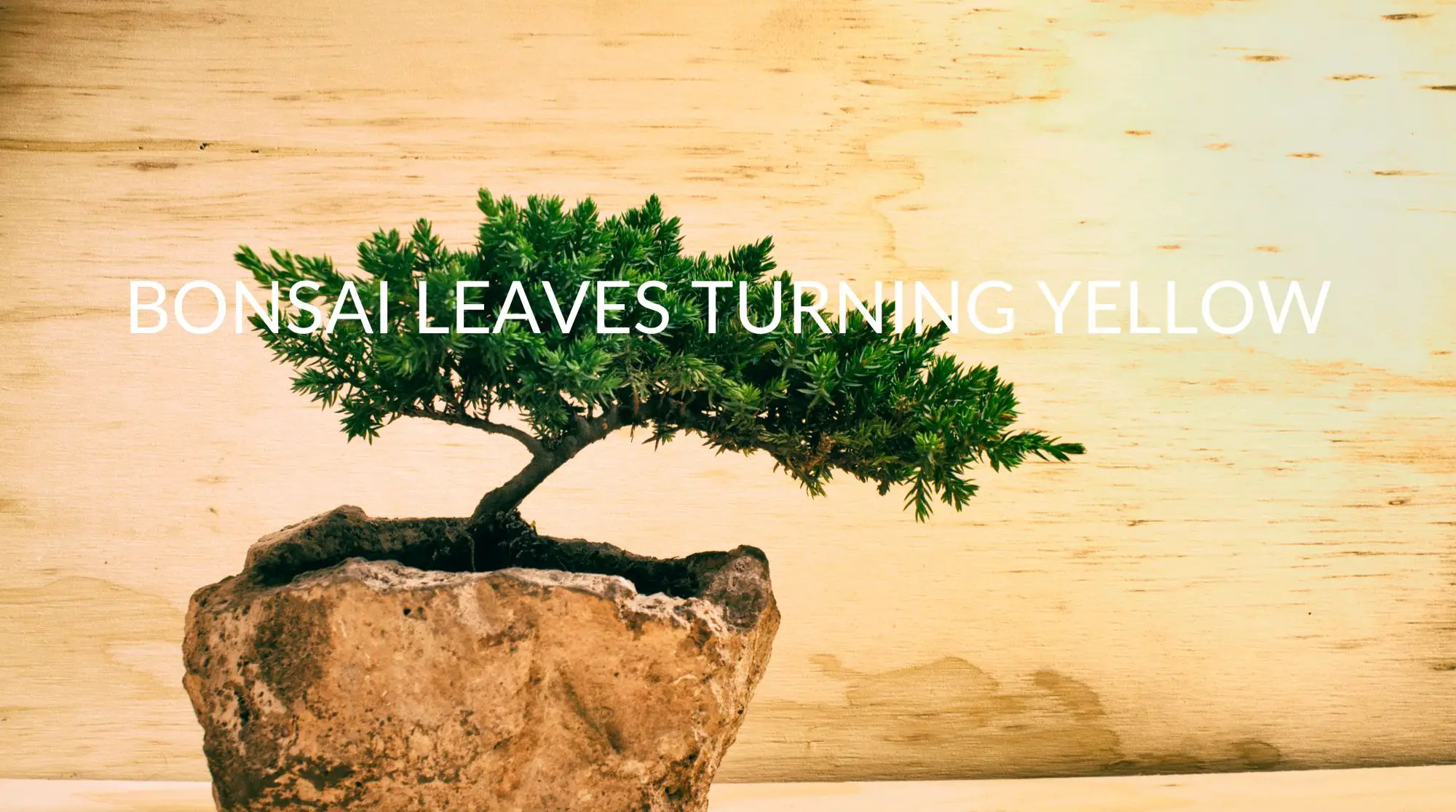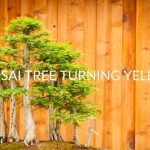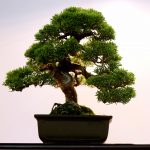Bonsai trees turning yellow is probably due to overwatering or underwatering. Other reasons might include inadequate light, over-pruning, repotting, or keeping a tree indoors when it should be grown outdoors.
Growing a Bonsai tree takes patience, practice, and keen powers of observation. Bonsai thrive in the right conditions, but it is sometimes difficult to tell what those conditions are. The first step to having a healthy Bonsai is to know what species you have and what it needs to thrive.
You can find out more about species identification here. For example, some Bonsai are deciduous and will naturally drop their leaves in the winter. If that is the reason for your yellow leaves, don’t worry. There are many other reasons for Bonsai to yellow and drop their leaves, however.
If your Bonsai tree has yellowing leaves, it is telling you something. Read on to figure out how to help your yellowing Bonsai.
Why Are My Bonsai Leaves Turning Yellow After Repotting?
Stress
Many potted plants take a little while to get used to a new growing environment. This could be due to repotting or being moved to a new location with different light, temperature, or humidity.
If your yellowing leaves don’t resolve in a week or so, consider whether your tree is under other stress. Is it by a heating or cooling vent? Open door or window? Was it moved to a location with less light or shorter days?
Don’t prune a Bonsai just after repotting, as it will cause undue stress to the tree.
Overwatering
You may have repotted your plant so that it gets enough water, but maybe you are overwatering. A larger pot will retain more water, and therefore you may not need to water as frequently.
In addition, if you repotted in soil that has less drainage, your pot will be retaining too much water, and that might be causing the leaves to be yellow. Make sure you use Bonsai soil that is sandy and has good drainage.
Sometimes it is easy to worry about a tree that has been repotted and accidentally overwatering it. Keep to the general rule of only watering a Bonsai when the top inch is dry.

Underwatering
Any time a plant is moved to a new pot, its water needs will adjust. If you repotted your Bonsai thinking that you could water it less frequently, it would take a month or so to figure out how much water the tree will need.
Like with all things Bonsai, you need to watch your tree carefully and get to know its needs.
Don’t repot your tree and then forget about it. Additionally, when repotting, you will need to make sure the tree gets thoroughly soaked (and then drained) during repotting so it can adjust to the soil.
Inadequate Light
If you repotted your tree and moved it, it may not be getting enough light. You will absolutely need to know your species of tree, so you will know how much light it requires. Many Bonsai require long hours of bright light or sunlight.
If you have an evergreen or deciduous tree, it will most likely need to be grown outdoors. Many common Bonsai are Juniper trees. If your Juniper is indoors, it will most likely turn yellow.
Only broadleaf evergreen Bonsai do well indoors, as they cannot tolerate cold. However, broadleaf evergreen trees generally require lots of bright light or sunlight, even indoors.
Keep in mind that in the winter, the days are shorter, and the tree might not be getting as much light. In this case, move to a brighter window or add grow lights.
Over Pruning
You may have been excited to get your Bonsai and put it in your favorite pot and try to shape it into a beautiful work of art. All of this is wonderful and takes time.
Many experts recommend only pruning and shaping your Bonsai once per year if it is healthy.
Likewise, repotting should only be done every year or every other year, depending on species, and most commonly in the spring.
Trees with yellow leaves should not be pruned while the leaves are yellow. Wait for the tree to regain its healthy green leaves before pruning.
Should You Remove Yellow Leaves From Your Bonsai?
Assuming you do not see pests, fungus, or disease on the leaves, yellow leaves will not harm the tree. Generally, yellow leaves will drop from a Bonsai in a fairly short amount of time.
If you are displaying your tree, you can remove them carefully, but try not to harm the other foliage.
The more important thing to remember is that yellow leaves are a signal that something isn’t right in the tree’s growing environment. Don’t just remove the leaves and ignore the problem. Bonsai cannot be ignored for long, as they will die quickly if they do not receive the right conditions.
How To Care For A Bonsai Tree That Is Turning Yellow
How to Figure Out Your Bonsai Species
Most Bonsai pros will tell you that you can’t care for your tree if you don’t know what kind it is. Different species of Bonsai will require different conditions. For example, evergreen and deciduous trees will need to be kept outdoors.
Broadleaf evergreens can be moved indoors in the winter months or grown indoors year-round, as long as there are warm temperatures and bright light.
If you have a deciduous tree and the leaves are yellowing and dropping in the autumn, this may be normal dormancy for that type of tree.
Since yellowing is probably due to issues with watering, light, pests, or fertilizer, you should know your species so you can figure out its particular needs.
Move Your Bonsai Outdoors
If you research your Bonsai species and find that it is an evergreen, such as a Juniper, Pine, Cypress, or Spruce, it will need to be grown outdoors. Move it outside slowly so it can adjust. It will probably eventually need bright light or sunlight (again, check the species!), but you should start it in bright, indirect light at first.
Likewise, if you have a fruit tree, Japanese Maple, Chinese Oak, Azalea, or other deciduous trees, it will also grow best outdoors.
If you have a subtropical species such as a Jade or Ficus, it will not tolerate cold temperatures and should be brought inside if temperatures dip below around 60℉ (15 ℃). Make sure it is in a bright (south-facing, if possible) window, or use grow lights.
Check the Roots
You will know if incorrect watering is the culprit by looking at the roots of your tree. Pull the roots gently out of the pot and inspect them. Healthy roots should look white. If you notice patches of brown or black roots with a rotting odor, that means your roots (and your tree) are unhealthy.
Root rot such as this causes the roots to be unable to absorb water and nutrients and could be a key reason you are having yellow leaves
If your Bonsai’s leaves are turning black, however, here are the possible reasons..
Gently trim the damaged roots off with sharp, clean pruning shears.
Root rot is often caused by inadequate drainage in the pot or overwatering. Make sure you know how much water your species needs and check your pot. You should have sandy Bonsai soil and a pot with adequate drainage.
Repot your Bonsai
Bonsai needs to be repotted approximately every other year, though this depends on the species of tree and its age.
If you notice that the roots are constricted in the pot, or if you have not repotted the tree in several years, it probably needs a fresh pot.
If you got a Bonsai from a large retailer, it is also a good idea to repot, since Bonsai trees not bought from Bonsai specialists generally aren’t potted adequately when they are sold.
Choose a pot no more than 1” larger than your old pot, and make sure you use Bonsai soil. Some species, like Juniper, like very sandy soil and cannot tolerate sitting in damp dirt.
After repotting, you can submerge your plant until the bubbles stop coming to the top and then place it somewhere where the excess water can drain off.
Choose the Correct Location
The correct location for a Bonsai depends on the species. Indoor Bonsai will need to be in bright windows with long exposure to light. They do not tolerate cold and should not be near drafty windows and doors or cooling vents.
In addition, some Bonsai do well with misting every so often in a dry climate.
If your tree is not getting adequate light, that is probably the reason for your yellow leaves. If you do not have south-facing windows, you can look into getting a grow light, especially for short winter days.
How Do You Revive A Yellow Bonsai Tree?
If your tree is very severely yellowed, you may not be able to revive it. However, that doesn’t mean you shouldn’t try.
Check Under The Bark For A Green Layer
Don’t assume a plant is dead before you try everything to revive it. If your tree has severe yellowing or the branches appear dry and dead, you can try to determine if it is alive by scraping a tiny amount of bark off with your (clean) fingernail.
If you see a healthy green layer underneath, or it looks like healthy wood, at least that part of the tree is still alive.
Inspect Your Bonsai For Pests
Again, know your species! Some Bonsai are more susceptible to certain pests, fungus, and diseases than others. If you do some research, you might figure out what could be harming your tree.
Inspect it thoroughly, including under the leaves. If you do find pests, you will need to use a pesticide that is recommended for your type of tree.
Don’t Stress It
If your tree has yellowing leaves, that is not the correct time to prune or shape it. Leave it alone until it grows healthy green leaves again. Even Bonsai with dead branches can be stunning. You may find that you want to incorporate these elements into the look of your tree.
If your tree is in adequate light and temperature, don’t move it. If it has been recently repotted and you aren’t worried about its drainage, don’t repot.
Try to achieve and maintain adequate conditions.
Know How Much Fertilizer You Need
Many Bonsai appreciate fertilizer during the growing season only (not during the winter). Again, this will depend on your species of tree.
Don’t over-fertilize, however. Less might be more. Some unhealthy trees should not be fertilized until they regain optimum health.
FAQ
Why Are My Serissa Bonsai Leaves Turning Yellow?
The Serissa, or “Snow Rose,” is a common Bonsai, but it is somewhat finicky and requires specific growing conditions. It is generally grown outdoors in temperatures above 50℉ (10℃). Serissa will yellow if it is too cold or if it is moved frequently.
Why Are My Fukien Tea Bonsai Leaves Turning Yellow?
The Fukien Tea (or “Carmona”) Bonsai can be grown indoors, but it requires lots of bright light. If your Fukien Tea is not getting enough light, consider growing with a grow light. Fukien Tea also does not tolerate cold temperatures and needs to be kept above 70 °F (20 °C), even at night.
Why Are My Juniper Bonsai Leaves Turning Yellow?
Juniper bonsais have to live outdoors year-round, and they require bright sunlight. Don’t prune all the growth tips of your Juniper, but do try to thin out foliage as needed. Junipers also require sandy soil and do not do well in soggy conditions, so make sure your pot has adequate drainage.
Conclusion
If you are an attentive Bonsai-grower, you will notice any yellow leaves right away and make any necessary corrections to the conditions of your tree.
Make sure you know the species of tree you have, so you will know what it needs to grow. It may be as simple as doing some research to determine what is optimal for your species of tree.
Make sure your tree is in the right location, getting adequate light, and correctly watered. Bonsai is a practice, and you will learn as you go!








